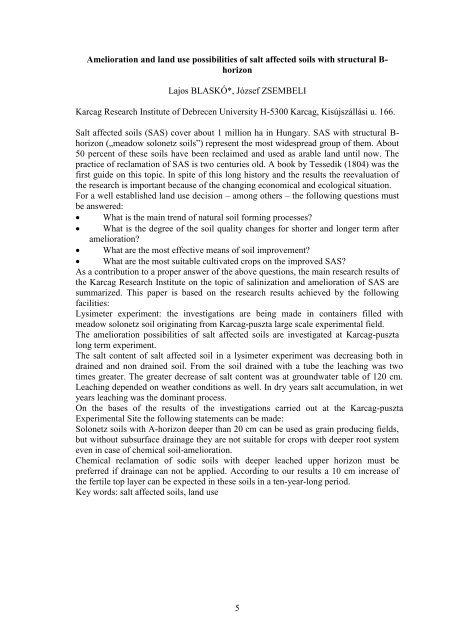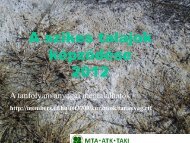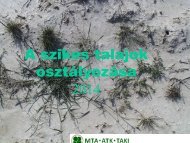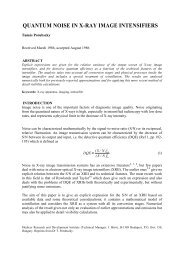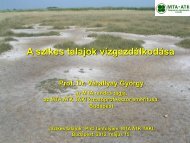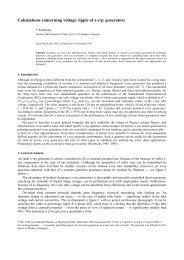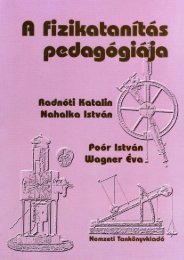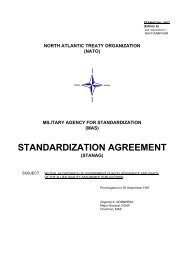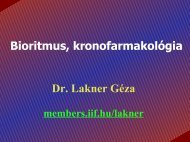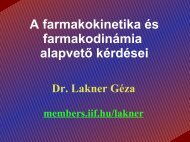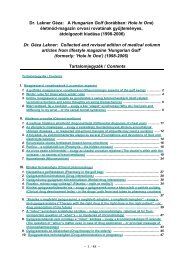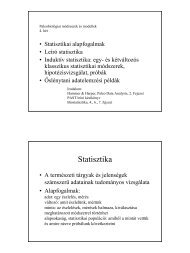Abstract form
Abstract form
Abstract form
Create successful ePaper yourself
Turn your PDF publications into a flip-book with our unique Google optimized e-Paper software.
Amelioration and land use possibilities of salt affected soils with structural B-<br />
horizon<br />
Lajos BLASKÓ*, József ZSEMBELI<br />
Karcag Research Institute of Debrecen University H-5300 Karcag, Kisújszállási u. 166.<br />
Salt affected soils (SAS) cover about 1 million ha in Hungary. SAS with structural B-<br />
horizon („meadow solonetz soils”) represent the most widespread group of them. About<br />
50 percent of these soils have been reclaimed and used as arable land until now. The<br />
practice of reclamation of SAS is two centuries old. A book by Tessedik (1804) was the<br />
first guide on this topic. In spite of this long history and the results the reevaluation of<br />
the research is important because of the changing economical and ecological situation.<br />
For a well established land use decision – among others – the following questions must<br />
be answered:<br />
What is the main trend of natural soil <strong>form</strong>ing processes?<br />
What is the degree of the soil quality changes for shorter and longer term after<br />
amelioration?<br />
What are the most effective means of soil improvement?<br />
What are the most suitable cultivated crops on the improved SAS?<br />
As a contribution to a proper answer of the above questions, the main research results of<br />
the Karcag Research Institute on the topic of salinization and amelioration of SAS are<br />
summarized. This paper is based on the research results achieved by the following<br />
facilities:<br />
Lysimeter experiment: the investigations are being made in containers filled with<br />
meadow solonetz soil originating from Karcag-puszta large scale experimental field.<br />
The amelioration possibilities of salt affected soils are investigated at Karcag-puszta<br />
long term experiment.<br />
The salt content of salt affected soil in a lysimeter experiment was decreasing both in<br />
drained and non drained soil. From the soil drained with a tube the leaching was two<br />
times greater. The greater decrease of salt content was at groundwater table of 120 cm.<br />
Leaching depended on weather conditions as well. In dry years salt accumulation, in wet<br />
years leaching was the dominant process.<br />
On the bases of the results of the investigations carried out at the Karcag-puszta<br />
Experimental Site the following statements can be made:<br />
Solonetz soils with A-horizon deeper than 20 cm can be used as grain producing fields,<br />
but without subsurface drainage they are not suitable for crops with deeper root system<br />
even in case of chemical soil-amelioration.<br />
Chemical reclamation of sodic soils with deeper leached upper horizon must be<br />
preferred if drainage can not be applied. According to our results a 10 cm increase of<br />
the fertile top layer can be expected in these soils in a ten-year-long period.<br />
Key words: salt affected soils, land use<br />
5


